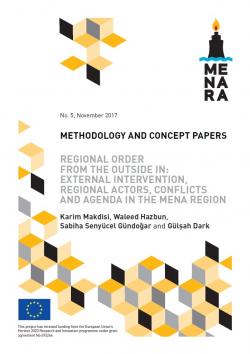Regional Order from the Outside In: External Intervention, Regional Actors, Conflicts and Agenda in the MENA Region
The Middle East and North Africa (MENA) region has been beset by a series of external interventions, regional crises and local conflicts – most recently precipitated by the Arab uprisings – that have led to major uncertainties and changes in the existing order. The aim of this paper – which launches Work Package 5 within the MENARA project – is to provide a general framework within which to understand and contextualize the transformations in regional dynamics, particularly since the uprisings. It is divided into four parts, focusing on the major regional actors (state and non-state); regional conflicts (Arab–Israeli, Syrian, Moroccan–Algerian and Sahel); themes (i.e. refugees and illegal trafficking); and key regional cooperation platforms (i.e. the Arab League, the Gulf Cooperation Council, the Arab Maghreb Union and the African Union). By introducing the basic background literature, approaches and research questions, this paper, in turn, paves the way for more in-depth and focused research papers within the MENARA project.
-
Details
Roma, IAI, November 2017, 24 p. -
In:
-
Issue
Methodology and Concept Papers 5
Introduction
1. Framing Regional Dynamics in the MENA Region
1.1 External Intervention and the Regional Order
1.2 Regional Powers and Rivalries
1.3 Morocco–Algeria Relations: Regional Turmoil
1.4 Key Non-State Actors and the Rise of ISIS
2. The Dimensions of Regional Conflicts
2.1 The Arab–Israeli Conflict
2.2 The Syria Conflict
2.3 The Maghreb–Sahel (In)Security Continuum
3. The Regional Agenda and Cooperation Platforms
3.1 The Refugee Crisis
3.2 Illegal Trafficking and Weapons Flows in the MENA Region
3.3 Regional Integration and Cooperation Dynamics
References



